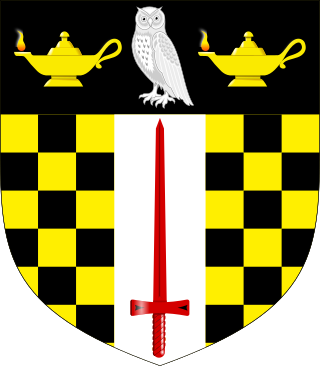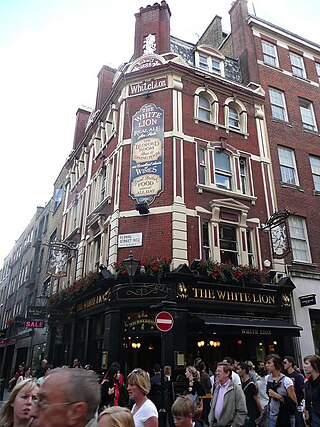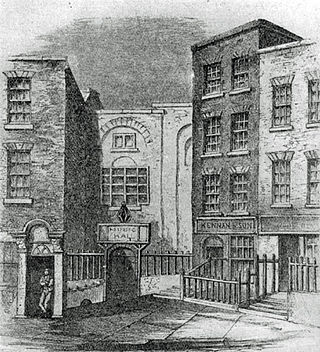
Strand is a major thoroughfare in the City of Westminster, Central London. The street, which is part of London's West End theatreland, runs just over 3⁄4 mile (1.2 km) from Trafalgar Square eastwards to Temple Bar, where the road becomes Fleet Street in the City of London, and is part of the A4, a main road running west from inner London.

George Birkbeck FRS was a British physician, academic, philanthropist, pioneer in adult education and a professor of natural philosophy at the Andersonian Institute. He is the founder of Birkbeck, University of London and was head of the Chemical Society. He is one of the creators of the earliest chemistry laboratory for undergraduates at University College London, and is also known for the creation of mechanics' institutes in Scotland and London.

Francis Place was an English social reformer described as "a ubiquitous figure in the machinery of radical London."

Birkbeck, University of London, is one of the world's top research university, located in Bloomsbury, London, England, and a member institution of the prestigious University of London. Established in 1823 as the London Mechanics' Institute by its founder, Sir George Birkbeck, and its supporters, Jeremy Bentham, J. C. Hobhouse and Henry Brougham, Birkbeck is one of the few universities to specialise in evening higher education in the United Kingdom.

The Anacreontic Society was a popular gentlemen's club of amateur musicians in London founded in the mid-18th century. These barristers, doctors, and other professional men named their club after the Greek court poet Anacreon, who lived in the 6th century B.C. and whose poems, "anacreontics", were used to entertain patrons in Teos and Athens. Dubbed "the convivial bard of Greece", Anacreon's songs often celebrated women, wine, and entertaining.

Exeter Hall was a large public meeting place on the north side of the Strand in central London, opposite where the Savoy Hotel now stands. From 1831 until 1907 Exeter Hall was the venue for many great gatherings by promoters of human betterment, most notably the anti-slavery movement.

Westminster was a parliamentary constituency in the Parliament of England to 1707, the Parliament of Great Britain 1707–1800 and the Parliament of the United Kingdom from 1801. It returned two members to 1885 and one thereafter.

The Grecian Coffee House was a coffee house, first established in about 1665 at Wapping Old Stairs in London, England, by a Greek former mariner called George Constantine.
The Association for Preserving Liberty and Property against Republicans and Levellers, also known as the Crown and Anchor Society or Crown and Anchor Association, was an English loyalist, anti-Jacobin, anti-Radical society active between late 1792 and June 1793.

The Freemasons' Tavern was established in 1775 at 61–65 Great Queen Street in the West End of London. It served as a meeting place for a variety of notable organisations from the 18th century until it was demolished in 1909 to make way for the Connaught Rooms.

Daly's Club, with premises known as Daly's Club House, was a gentlemen's club in Dublin, Ireland, a centre of social and political life between its origins in about 1750 and its end in 1823.
John Gale Jones (1769–1838) was an English radical orator. Until its suppression in 1798, he was active in the London Corresponding Society. He was several times imprisoned for provocative agitation against the government.
The Hampden Clubs were political campaigning and debating societies formed in England in the early 19th century as part of the Radical Movement. They were particularly concentrated in the Midlands and the northern counties, and were closely associated with the popular movements for social and political reform that arose in the years following the end of the Napoleonic Wars. They were forced underground, and eventually disbanded in the face of legislation and pressure from the authorities.
John Martineau the younger was an English sugar refiner and engineer, best known for his involvement in the firm Taylor & Martineau.
The London Philhellenic Committee (1823–1826) was a Philhellenic group established to support the Greek War of Independence from Ottoman rule by raising funds by subscription for military supplies to Greece and by raising a major loan to stabilize the fledgling Greek government. Its first meeting was held on 28 February 1823 in the Crown and Anchor Tavern on the Strand.

The City of London Tavern or London Tavern was a notable meeting place in London during the 18th and 19th centuries. A place of business where people gathered to drink alcoholic beverages and be served food, the tavern was situated in Bishopsgate in the City of London. The original tavern was destroyed in a fire on 7 November 1765 and the new building was designed by William Jupp the elder and opened in September 1768. In 1828, the proprietor was Charles Bleaden. The building was demolished in 1876. The tavern boasted a large and well-decorated dining room with Corinthian columns. It hosted numerous public and private meetings held to rally support to various political, charitable and other causes.

The White Lion is a pub in Covent Garden, London, on the corner of James Street and Floral Street.

The Whalebone was an eatery on Lothbury in the City of London that was a meeting place for the Leveller movement in the mid 17th century. The Levellers described themselves as "whaleboners" in an early printed declaration, and their leader John Lilburne would read various declarations and lead meetings there. Henry Ireton, Oliver Cromwell's son-in-law, sent spies to the Whalebone to observe the Levellers. It was referred to as one of the Levellers' 'Houses of Parliament', along with the Mouth Inn in Aldersgate. The Windmill Tavern was similarly associated with the Levellers.

Neale's Musick Hall, also known as Mr. Neal's New Musick Hall, the New Musick-Hall, Mr. Neale's Great Room, Neal's Musick Room, the Great Musick Hall, Mr. Neale's Great Musick Hall or the Fishamble Street Music Hall was a purpose-built music hall that existed on Fishamble Street in Dublin city centre. It was built using subscriptions from a charitable organisation named 'The Charitable and Musical Society', and operated from 1741 until the mid-19th century. William Neale, a local musical instrument-maker and music publisher, was the secretary/treasurer of the society during the conception and construction phase of the project. The building is most notable for the premiere of Handel's Messiah which took place within it on the afternoon of 13 April 1742.















